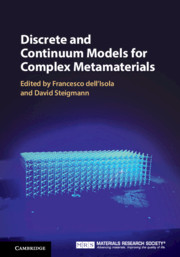Book contents
- Frontmatter
- Contents
- List of Contributors
- Part I Designing Complex (Meta)Materials: Results and Perspectives
- Part II Mathematical and Numerical Methods
- 4 Naive Model Theory: Its Applications to the Theory of Metamaterials Design
- 5 Lagrangian Discrete Models: Applications to Metamaterials
- 6 Experimental Methods in Pantographic Structures
- 7 Variational Methods as Versatile Tools in Multidisciplinary Modeling and Computation
- 8 Least Action and Virtual Work Principles for the Formulation of Generalized Continuum Models
- Index
6 - Experimental Methods in Pantographic Structures
from Part II - Mathematical and Numerical Methods
Published online by Cambridge University Press: 20 February 2020
- Frontmatter
- Contents
- List of Contributors
- Part I Designing Complex (Meta)Materials: Results and Perspectives
- Part II Mathematical and Numerical Methods
- 4 Naive Model Theory: Its Applications to the Theory of Metamaterials Design
- 5 Lagrangian Discrete Models: Applications to Metamaterials
- 6 Experimental Methods in Pantographic Structures
- 7 Variational Methods as Versatile Tools in Multidisciplinary Modeling and Computation
- 8 Least Action and Virtual Work Principles for the Formulation of Generalized Continuum Models
- Index
Summary
Once a metamaterial has been conceived, designed and built, its expected properties must be experimentally verified, in order to validate the conceptual analysis leading to it and the construction process used to realize it. Using 3D printing technology is not always a trivial task, especially if the designed microstructures are complex and show large differences in their geometrical and mechanical properties, at lower scales. Moreover, once some specimens are built, some specific experimental apparatuses have to be designed that are able to manifest the specific desired exotic mechanical features which are the target of the whole research effort. Therefore it is not a simple task to prove that the pantographic microstructured metamaterials do really exhibit the behavior which is expected. The gathered evidence which shows the validity of the concept of pantographic metamaterial is carefully presented here.
Keywords
- Type
- Chapter
- Information
- Discrete and Continuum Models for Complex Metamaterials , pp. 263 - 297Publisher: Cambridge University PressPrint publication year: 2020
- 9
- Cited by



